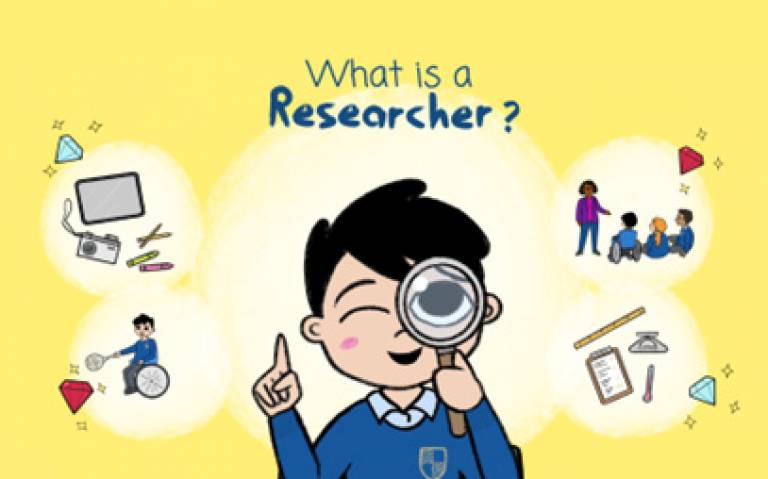This project aimed to develop a short, engaging video to help young children better understand research. The video can be used by researchers from many fields to help them explain what they do.

About the project
We hope this pilot project will be a first step in developing a suite of resources to support the informed consent process.
Project timeline: January - July 2022
- Team
- Laura Benton - Project leader (IOE)
- Julia Truscott - Childhood & Youth Research for All (CYRA) service
- Background
Researchers often involve young children in their work. Hearing directly from children helps to better understand their experiences.
As a first step, researchers working with children need to explain their research to children (and their parent/guardian) to help them decide if they would like to take part. However, children are often not familiar with the role of a researcher.
For children to make an informed choice, they need to have some idea of what 'research' actually is, but it can be difficult to explain this to them in a simple understandable way. Therefore, through this project we have developed a resource that aims to support the informed consent process with young child research participants.
- Methodology
Phase 1 (2 months)
The project began with a cross-disciplinary literature review as well as consultation with experienced child researchers to collate a range of definitions of what it means to be a researcher.
Phase 2 (3 months)
In collaboration with the The CYRA service and professional illustrator, Holly Smith, we storyboarded the video resource and produced an initial animated draft video.
This phase also involved seeking feedback from young children on a draft version of the video to ensure it was understandable, engaging and accessible. Based on this feedback further refinements were made.Phase 3 (1 month)
We sought further feedback from children as well as feedback from researchers with previous experience of working with children via an online survey to determine the suitability and usefulness of the resource. The survey also obtained feedback on any final improvements that could be made and ideas for the development of future resources.
Phase 4 (1 month)
Lastly we identified dissemination opportunities for the final video resource via IOE/UCL ethics as well as international ethics organisations, associated networks and children’s charities.
- Acknowledgments
A big thank you to Holly Smith for the beautiful illustrations. You can view more of Holly’s fantastic work on her social pages @hollysmith_illo.
We are also very grateful to the children and their parents who provided valuable feedback on earlier versions of this video.
Many thanks to Dr Magda Morawska from the UCL Research Integrity team for her valuable guidance, helpful suggestions and encouragement throughout this project.
Lastly, thank you to all of the researchers who took the time to watch the video and share their ideas about how the video could be used as well as expanded upon in the future.
- References
Below is a list of previously published work which helped to inspire and guide the development of this video:
- Arnott, L., Martinez-Lejarreta, L., Wall, K., Blaisdell, C., & Palaiologou, I. (2020). Reflecting on three creative approaches to informed consent with children under six. British Educational Research Journal, 46(4), 786-810.
- Dockett, S., Perry, B., & Kearney, E. (2012). Promoting children’s informed assent in research participation. International Journal of Qualitative Studies in Education, 26(7), 802-828.
- Grootens-Wiegers, P., de Vries, M. C., van Beusekom, M. M., van Dijck, L., & van den Broek, J. M. (2015). Comic strips help children understand medical research: targeting the informed consent procedure to children’s needs. Patient Education and Counseling, 98(4), 518-524.
- Lundy, L., & McEvoy, L. (2012). Children’s rights and research processes: Assisting children to (in)formed views. Childhood, 19(1). 129-144.
- Martin-Kerry, J. et al (2019). Supporting children and young people when making decisions about joining clinical trials: Qualitative study to inform multimedia website development. BMJ Open, 9, e023984.
- Mayne, F., & Howitt, C. (2022). The Narrative Approach to informed consent: Empowering young children’s rights and meaningful participation. Routledge.
- McInroy, L. B. (2017). Innovative ethics: Using animated videos when soliciting informed consent of young people for online surveys. Social Work Research, 41(2), 121-128.
- Murray, J. (2016). Young children are researchers: Children aged four to eight years engage in important research behaviour when they base decisions on evidence. European Early Childhood Education Research Journal, 24(5), 705-720.
- Murray, J. (2017). Welcome in! How the academy can warrant recognition of young children as researchers. European Early Childhood Education Research Journal, 25(2), 224-242.
- Parsons, S., Sherwood, G., & Abbott, C. (2016). Informed consent with children and young people in social research: Is there scope for innovation? Children & Society, 30(2), 132-145.
- Read, J.C., Horton, M., Fitton, D., & Sim, G. (2017). Empowered and informed: Participation of children in HCI. IFIP Conference on Human-Computer Interaction. Part of the Lecture Notes in Computer Science Book Series (LNISA, Vol. 10514). Springer Link.
- Rogers, R., & Labadie, M. (2018). Rereading assent in critical literacy research with young children. Journal of Early Childhood Literacy, 18(3), 396-427.
- Ruiz-Casares, M., & Thompson, J. (2016). Obtaining meaningful informed consent: Preliminary results of a study to develop visual informed consent forms with children. Children’s Geographies, 14(1), 35-45.
 Close
Close

